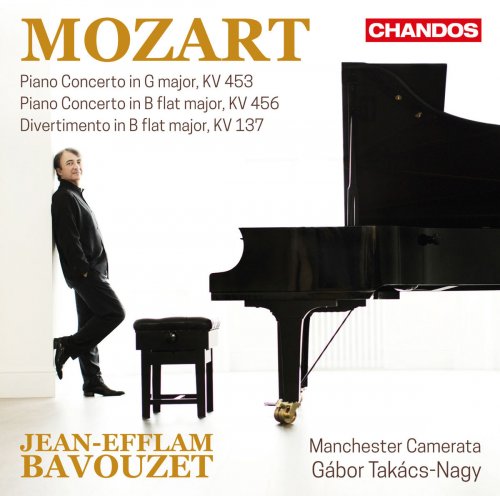Jean-Efflam Bavouzet, Manchester Camerata & Gábor Takács-Nagy - Mozart: Piano Concertos (2016) [Hi-Res]

Artist: Jean-Efflam Bavouzet, Manchester Camerata & Gábor Takács-Nagy
Title: Mozart: Piano Concerto
Year Of Release: 2016
Label: Chandos
Genre: Classical, Piano
Quality: flac lossless / flac 24bits - 96.0kHz +booklet
Total Time: 01:14:39
Total Size: 307 mb / 1.2 gb
WebSite: Album Preview
TracklistTitle: Mozart: Piano Concerto
Year Of Release: 2016
Label: Chandos
Genre: Classical, Piano
Quality: flac lossless / flac 24bits - 96.0kHz +booklet
Total Time: 01:14:39
Total Size: 307 mb / 1.2 gb
WebSite: Album Preview
---------
01. Piano Concerto No. 17 in G Major, K. 453: Ia. Allegro
02. Piano Concerto No. 17 in G Major, K. 453: Ib. Cadenza (By Bavouzet)
03. Piano Concerto No. 17 in G Major, K. 453: IIa. Andante
04. Piano Concerto No. 17 in G Major, K. 453: IIb. Cadenza (By Bavouzet)
05. Piano Concerto No. 17 in G Major, K. 453: III. Allegretto
06. Piano Concerto No. 18 in B-Flat Major, K. 456: I. Allegro vivace
07. Piano Concerto No. 18 in B-Flat Major, K. 456: II. Andante un poco sostenuto
08. Piano Concerto No. 18 in B-Flat Major, K. 456: III. Allegro vivace
09. Divertimento in B-Flat Major, K. 137 "Salzburg Symphony No. 2": I. Andante
10. Divertimento in B-Flat Major, K. 137 "Salzburg Symphony No. 2": II. Allegro di molto
11. Divertimento in B-Flat Major, K. 137 "Salzburg Symphony No. 2": III. Allegro assai
12. Piano Concerto No. 17 in G Major, K. 453 (Excerpt): I. Cadenza [Original]
13. Piano Concerto No. 17 in G Major, K. 453 (Excerpt): II. Cadenza [Original]
After demonstrating their ‘innate love and understanding of Haydn’s music in performances of the expected vivacity and insight’ (BBC Music), Bavouzet and Takacs-Nagy, the latter conducting his Manchester Camerata, now explore Mozart’s extraordinary prolific year 1784 in this new series. Two of the six concertos that year are heard here, each unusual for having been written by Mozart for another pianist and for featuring a central Andante, instead of the more common Adagio. This is a unique version that, as Bavouzet stresses in his booklet note, ‘although played unequivocally on modern instruments, contrasts with those versions made not so very long ago, which used a large orchestra incorporating sixteen violins and eight double-basses.’ He adds: ‘a versions which also will take into account a number of performing practices current in Mozart’s time, such as the use of a solo quartet to accompany certain well-defined passages in which the piano is predominant. A version which in one way or another aims to link tradition and modernity.’

![The Mood Mosaic - Acid Maestro (Morricone's Cosmic Funk Legacy) (2025) [Hi-Res] The Mood Mosaic - Acid Maestro (Morricone's Cosmic Funk Legacy) (2025) [Hi-Res]](https://www.dibpic.com/uploads/posts/2025-12/1766134708_dkymenaq6pxqa_600.jpg)
![The Mood Mosaic - The Sexploitation (Pulp Grooves From The Mondo Porno Vault) (2025) [Hi-Res] The Mood Mosaic - The Sexploitation (Pulp Grooves From The Mondo Porno Vault) (2025) [Hi-Res]](https://www.dibpic.com/uploads/posts/2025-12/1766131648_uhod8d4qn4msi_600.jpg)




![Tomasz Stanko - Unit (Polish Radio Sessions vol. 2/6) (2025) [Hi-Res] Tomasz Stanko - Unit (Polish Radio Sessions vol. 2/6) (2025) [Hi-Res]](https://www.dibpic.com/uploads/posts/2025-12/1765796826_cover.jpg)
